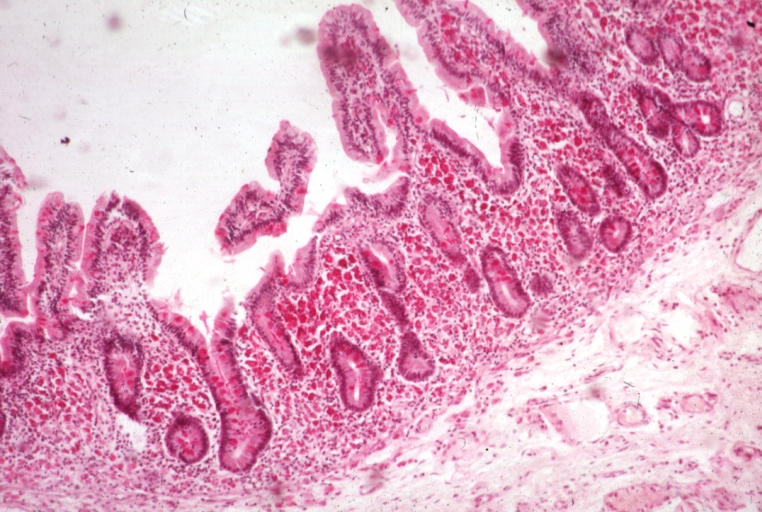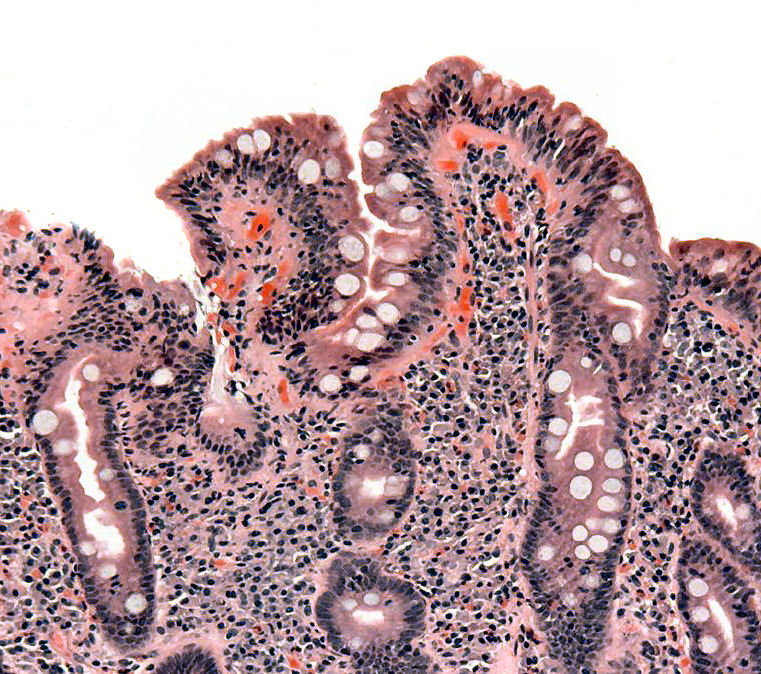Malabsorption: Difference between revisions
No edit summary |
No edit summary |
||
| Line 175: | Line 175: | ||
[[Category:Gastroenterology]] | [[Category:Gastroenterology]] | ||
[[Category:Mature chapter]] | |||
[[Category:Needs patient information]] | |||
[[Category:Disease state]] | |||
[[de:Malassimilation]] | [[de:Malassimilation]] | ||
Revision as of 00:11, 1 August 2011
| Alternative names |
|---|
| Malabsorption syndrome
Malabsorption syndrome (disorder) |
| Subordinate terms |
| Intestinal malabsorption |
| Malabsorption | |
 | |
|---|---|
| Whipple's disease: Alcian blue with apparently eosin counterstain enlarged villus with many macrophages | |
| ICD-10 | (K90) |
| ICD-9 | 579 |
| DiseasesDB | 7698 |
| MedlinePlus | 000299 |
| eMedicine | med/1384 |
Template:Search infobox Editor-In-Chief: C. Michael Gibson, M.S., M.D. [2]
Please Take Over This Page and Apply to be Editor-In-Chief for this topic: There can be one or more than one Editor-In-Chief. You may also apply to be an Associate Editor-In-Chief of one of the subtopics below. Please mail us [3] to indicate your interest in serving either as an Editor-In-Chief of the entire topic or as an Associate Editor-In-Chief for a subtopic. Please be sure to attach your CV and or biographical sketch.
Synonyms and keywords: Malabsorption syndrome
Overview
Malabsorption is a state arising from abnormality in digestion or absorption of food nutrients across the gastrointestinal(GI) tract.
Impairment can be of single or multiple nutrients depending on the abnormality. This may lead to malnutrition and variety of anaemias[1].
Some prefer to classify malabsorption clinically into three basic categories[2]:
- (1) selective, as seen in lactose malabsorption;
- (2) partial, as observed in a-Beta-lipoproteinemia, and
- (3) total as in celiac disease.
Pathophysiology
The main purpose of the GI tract is to digest and absorb nutrients (fat, carbohydrate, and protein), micronutrients (vitamins and trace minerals), water, and electrolytes. Digestion involves both mechanical and enzymatic breakdown of food. Mechanical processes include chewing, gastric churning, and the to-and-fro mixing in the small intestine. Enzymatic hydrolysis is initiated by intraluminal processes requiring gastric, pancreatic, and biliary secretions. The final products of digestion are absorbed through the intestinal epithelial cells.
Malabsorption constitutes the pathological interference with the normal physiological sequence of digestion (intraluminal process), absorption (mucosal process) and transport (postmucosal events) of nutrients[3].
Intestinal malabsorption can be due to[4]
- mucosal damage (enteropathy)
- congenital or acquired reduction in absorptive surface
- Defects of specific hydrolysis
- Defects of ion transport
- pancreatic insuffeciency
- impaired enterohepatic circulation
Causes
Due to infective agents
- Whipple's disease
- Intestinal tuberculosis
- HIV related malabsorption
- Tropical sprue
- traveller's diarrhoea
- Parasites .e. g. Giardia lamblia, fish tape worm (B12 malabsorption); round warm , hookworm (Ancylostoma duodenale and Necator americanus)
Due to structural defects[5]
- Blind loops
- Inflammatory bowel diseases commonly in Crohn's Disease
- Intestinal hurry from Post-gastrectomy; post-vagotomy, gastro-jejunostomy
- Fistulae, diverticulae and strictures,
- Infiltrative conditions such as amyloidosis, lymphoma, Eosinophilic gastroenteropathy
- Radiation enteritis
- Systemic sclerosis and collagen vascular diseases
Due to mucosal abnormality
- Coeliac disease
- Cows' milk intolerance
- Soya milk intolerance
Due to enzyme defeciencies
- Lactase deficiency inducing lactose intolerance (constitutional, secondary or rarely congenital)
- Sucrose intolerance
- Intestinal disaccharidase defeciency
- Intestinal enteropeptidase defeciency
Due to digestive failure
- Pancreatic insuffeciencies:
- Bile salt malabsorption
- terminal ileal disease
- obstructive jaundice
- bacterial overgrowth
Due to other systemic diseases affecting GI tract
- Hypothyroidism and hyperthyroidism
- Addison's disease
- Diabetes mellitus
- Hyperparathyroidism and Hypoparathyroidism
- Carcinoid syndrome
- Malnutrition
- Abeta-lipoproteinemia
Clinical features

It can present in variety of ways and features might give clue to underlying condition. Symptoms can be intestinal or extra-intestinal, former predominates in severe malabsorption.
- Diarrhoea,often steatorrhoea is the most common feature. Watery, diurnal and nocturnal, bulky, frequent stools are the clinical hallmark of overt malabsorption. It is due to impaired water, carbohydrate and electrolyte absorption or irritation from unabsorbed fatty acid. Latter also result in bloating, flatulence and abdominal discomfort. Cramping pain usually suggest obstructive intestinal segment e.g. in crohn's disease especially if persists after defecation. [3]
- Weight loss can be significant despite increased oral intake of nutrients[6].
- Growth retardation, failure to thrive, delayed puberty in children
- Swelling or oedema from loss of protein
- Anaemias, commonly from vitamin B12, folic acid and iron defeciency presenting as fatigue and weakness.
- Muscle cramp from decreased vitamin D, calcium absorption. Also lead to osteomalacia and osteoporosis
- Bleeding tendencies from vitamin K and other coagulation factor defeciencies.
Diagnosis
There is no specific test for Malabsorption. As for most medical conditions, investigation is guided by symptoms and signs. Moreover, tests for pancreatic function are complex and varies widely between centres.
Blood Tests
- Routine blood tests may reveal anaemia, high ESR or low albumin; which has high sensitivity for presence of organic disease [7][8]. In this setting, microcytic anaemia usually implies iron deficiency and macrocytosis can be from impaired folic acid or B12 absorption or both. Low cholesterol or triglyceride may give clue toward fat malabsorption as low calcium and phosphate toward osteomalacia from low vitamin D.
- Specific vitamins like vitamin D or micro nutrient like zinc levels can be checked. Fat soluble vitamins (A, D, E & K) are affected in fat malabsorption. Prolonged prothrombin time can be from vitamin K deficiency.
- Serological studies
- Specific tests are carried out to determine underlying cause.
- IgA tissue trans glutamate or IgA antiendomysium assay for gluten sensitive enteropathy.
Stool studies
- Microscopy is particularly useful in diarrhoea, may show protozoa like giardia, ova, cyst and other infective agents.
- Fecal fat study to diagnose steatorrhoea is less frequently performed nowadays.
- Low elastase is indicative of pancreatic insufficiency. Chymotrypsin and pancreolauryl can be assessed as well[9]
Radiological studies
- Barium follow through is useful in delineating small intestinal anatomy. Barium enema may be undertaken to see colonic or ileal lesions.
- CT abdomen is useful in ruling out structural abnormality, done in pancreatic protocol when visualising pancreas.
- MRCP to complement or as an alternative to ERCP
Interventional studies

- Endoscopy is frequently undertaken, but to visualise small intestine which can be up to 7m long is indeed a daunting task.
- OGD to reveal duodenal lesion also for D2 biopsy (for celiac disease, tropical sprue, Whipple disease, A-b-lipoproteinemia etc.)
- Enteroscopy for enteropathy and jejunal aspirate and culture for bacterial overgrowth
- Colonoscopy is helpful in colonic or ileal lesion.
Other investigations
- Radio isotope tests e.g. 75SeHCAT, 95mTc to exclude terminal ileal disease.
- Sugar probes or sub 51Cr-EDTA to determine intestinal permeability[3].
- Glucose hydrogen breath test for bacterial overgrowth
- D-xylose absorption test. lower level in urine after ingestion indicates bacterial overgrowth or reduced absorptive surface. normal in pancreatic insufficiency.
- Bile salt breath test to determine bile salt malabsorption.
- Schilling test to establish cause of B12 deficiency.
- Lactose H2 breath test for lactose intolerance
Management
Treatment is directed largely towards management of underlying cause.
- Replacement of nutrients, electrolytes and fluid may be necessary. In severe defeciency hospital admission may be required for parentral administration, often advice from dietician is sought. People whose absortive surface are severely limited from disease or surgery may need long term total parenteral nutrition. Pancreatic enzymes are supplimented orally in insuffeciencies.
- Dietary modification is important in some conditions. Life long avoidance of particular food or food constituent may be needed in Celiac disease or lactose intolerence.
- Bacterial overgrowth usually respond well to course of antibiotic. Use of cholestyramine to bind bile acid will help reducing diarrhoea in bile acid malabsorption.
See also
External links
- Practice guideline from World Gastroenterology Organisation [4]
- Tests for malabsorption; from British Society for Gastroenterology (2003)[5]
Reference
- ↑ Jensen, Jonathan E. "Malabsorption Syndromes - Page 1". Colorado center for digestive disorders. Retrieved 2007-05-10.
- ↑ Gasbarrini G, Frisono M: Critical evaluation of malabsorption tests; in G. Dobrilla, G. Bertaccini, G. Langman (Editor) (1986). Problems and Controversies in Gastroenterology. New York: Raven Pr. pp. 123–130. ISBN 88-85037-75-5.
- ↑ 3.0 3.1 3.2 Bai J (1998). "Malabsorption syndromes". Digestion. 59 (5): 530–46. PMID 9705537.
- ↑ Walker-Smith J, Barnard J, Bhutta Z, Heubi J, Reeves Z, Schmitz J (2002). "Chronic diarrhea and malabsorption (including short gut syndrome): Working Group Report of the First World Congress of Pediatric Gastroenterology, Hepatology, and Nutrition". J. Pediatr. Gastroenterol. Nutr. 35 Suppl 2: S98–105. PMID 12192177.
- ↑ M. S Losowsky,. Malabsorption in clinical practice. Edinburgh: Churchill Livingstone. ISBN 0-443-01007-2.
- ↑ health ato z "Malabsorption syndrome". Retrieved 2007-05-10.
- ↑ Bertomeu A, Ros E, Barragán V, Sachje L, Navarro S (1991). "Chronic diarrhea with normal stool and colonic examinations: organic or functional?". J. Clin. Gastroenterol. 13 (5): 531–6. PMID 1744388.
- ↑ Read N, Krejs G, Read M, Santa Ana C, Morawski S, Fordtran J (1980). "Chronic diarrhea of unknown origin". Gastroenterology. 78 (2): 264–71. PMID 7350049.
- ↑ Thomas P, Forbes A, Green J, Howdle P, Long R, Playford R, Sheridan M, Stevens R, Valori R, Walters J, Addison G, Hill P, Brydon G (2003). "Guidelines for the investigation of chronic diarrhoea, 2nd edition". Gut. 52 Suppl 5: v1–15. PMID 12801941.[1].
Template:SIB Template:Gastroenterology
de:Malassimilation sv:Malabsorption